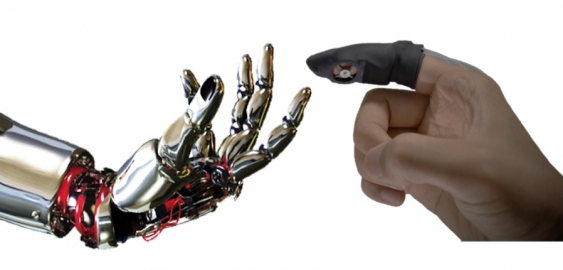创新背景
触觉是许多人习以为常的完成日常任务的能力。当人们用手做事情时,比如拿手机或在键盘上打字,所有这些动作都离不开触觉。
人类的手有高密度的触觉感受器,这是一个通过触觉刺激编码信息的有趣和富有挑战性的区域,因为我们每天都用手感知大多数物体。
在很多情况下触觉是有用的,但很多时候人们无法依赖触觉:例如,在远程健康咨询中,医生无法亲自检查病人。所以,科学家的目标是解决这个问题。
创新过程
如果人们可以在视频通话期间触摸亲人(尤其是在当今COVID-19的社交距离时代),或者在视频游戏中拿起并处理虚拟工具,该怎么办?
新南威尔士大学悉尼分校的工程师开发出一种新的触觉设备后,这些想法可能在几年内成为现实。这种设备可以重现触觉。
触觉技术通过刺激皮肤的局部区域来模拟触摸体验,这种刺激方式与现实世界中的感觉类似,比如通过力、振动或运动。
科学讲师、新南威尔士大学医学机器人实验室主任Thanh Nho Do博士是一项新设备研究的资深作者。他的研究团队包括第一作者和博士候选人Mai Thanh Thai、Phuoc Thien Phan、Trung Thien Hoang和合作者生物医学工程研究生院院长、科学教授Nigel Lovell。
新型三向皮肤拉伸装置(SSD)内置在研究人员发明的可穿戴触觉手套的指尖上,就像戴上了第二层皮肤——它柔软、可拉伸,并模仿触觉——将使新的触觉交流形式增强日常活动。

这项新技术的另一个特别之处在于,它是可扩展的,可以集成到纺织品中,用于各种潜在的应用,如远程医疗、医疗设备、手术机器人和培训、增强和虚拟现实、远程操作和工业环境。
如何工作
研究人员的新技术克服了现有触觉设备的问题,通过引入一种新的方法,通过柔软的微型人造“肌肉”来重建有效的触觉。
柔软、可穿戴的触觉手套使人们能够以更真实和沉浸的方式感受虚拟或远程物体。内置的人造软肌肉通过软触媒向使用者的指尖产生足够的法力和剪力,使他们能够有效地再现触觉。

它是这样运作的:用户想象自己在澳大利亚,而朋友在美国。用户戴上触觉手套,指尖上有新开发的集成的三向定向固态硬盘,朋友也戴上集成的3D力传感器手套。
当朋友拿起一个东西时,它就会压在朋友的手指上,手套上的3D力传感器会测量这些相互作用。如果这些3D力信号被发送到用户的触觉手套,那么集成的三向定向ssd将在用户的指尖产生这些精确的3D力,使用户能够体验到和朋友一样的触觉。
创新关键点
新型三向皮肤拉伸装置(SSD)内置在研究人员发明的可穿戴触觉手套的指尖上,就像戴上了第二层皮肤——它柔软、可拉伸,并模仿触觉——将使新的触觉交流形式增强日常活动。
这项新技术的另一个特别之处在于,它是可扩展的,可以集成到纺织品中,用于各种潜在的应用,如远程医疗、医疗设备、手术机器人和培训、增强和虚拟现实、远程操作和工业环境。
创新价值
该设备旨在解决新兴系统中的一个常见问题,如辅助设备、远程手术、自动驾驶汽车和人体运动指导,这些系统中的视觉或听觉反馈可能缓慢、不直观,并增加认知负荷。
杜博士表示,通过新型可穿戴触觉设备有效再现触觉的能力将会带来广泛的好处:例如,在今天的COVID-19大流行期间,人们依靠视频电话与亲人保持联系。
与现有的触觉设备不同,这项新技术是柔软、轻便和轻薄的,因此,研究人员希望用户能够将它与他们的穿戴相结合,在康复、教育、培训和娱乐等环境中提供真实的触觉体验。
新技术还可以让用户感受到虚拟世界内或远处的物体,例如,科学家不用离开实验室就能感觉到来自另一个星球的虚拟岩石,或者外科医生不用直接接触手术工具就能感觉到病人的器官组织。
Innovation and development of new wearable devices can help simulate the sense of touch
What if people could touch loved ones during video calls (especially in today's era of social distancing from COVID-19), or pick up and handle virtual tools in a video game?
These ideas could become a reality within a few years after engineers at the University of New South Wales in Sydney developed a new haptic device. The device can reproduce the sense of touch.
Haptic technology simulates the experience of touch by stimulating local areas of the skin in a way that is similar to what is felt in the real world, such as through force, vibration or movement.
Dr Thanh Nho Do, a science lecturer and director of the Medical Robotics Laboratory at the University of New South Wales, is the senior author of a new device study. His research team included first authors and doctoral candidates Mai Thanh Thai, Phuoc Thien Phan, Trung Thien Hoang, and collaborator Nigel Lovell, Dean of the Graduate School of Biomedical Engineering and Professor of Science.
Built into the fingertips of researchers' wearable tactile gloves, the new three-way skin stretching device (SSD) is like wearing a second skin -- it's soft, stretchy, and mimics the sense of touch -- and will enable new forms of tactile communication to enhance daily activities.
What is also special about this new technology is that it is scalable and can be integrated into textiles for a variety of potential applications such as telemedicine, medical devices, surgical robotics and training, augmented and virtual reality, teleoperation and industrial environments.
How to work
The researchers' new technique overcomes the problems with existing haptic devices by introducing a new way to recreate an effective sense of touch through soft, miniature artificial "muscles."
Soft, wearable tactile gloves enable people to feel virtual or remote objects in a more realistic and immersive way. The built-in artificial soft muscles produce enough magic and shear force to the user's fingertips through soft accelerators, allowing them to effectively reproduce the sense of touch.
Here's how it works: users imagine they are in Australia and their friends are in the United States. Users wear tactile gloves with newly developed integrated three-way directional solid-state drives on their fingertips, and friends also wear integrated 3D force sensor gloves.
When a friend picks up an object, it presses down on the friend's finger, and a 3D force sensor on the glove measures these interactions. If these 3D force signals are sent to the user's tactile glove, then the integrated three-way directional SSD will generate these precise 3D forces at the user's fingertips, enabling the user to experience the same sense of touch as their friends.
智能推荐
机器人+仿生学 | 创新开发柔软织物机器人抓手更易于处理易碎物品
2022-11-03大自然启发了悉尼新南威尔士大学的工程师开发一种柔软的织物机器人抓手,它的行为就像大象的鼻子一样,可以抓住、拾取和释放物体而不会破坏它们。
涉及学科涉及领域研究方向微生物学创新 | 应用新型工具”CLASH”可在MRSA菌株中捕获未被发现的基因调控机制
2022-09-23研究人员已经在金黄色葡萄球菌中发现了一个复杂的适应系统,识别和表征了多药耐药的机制,并为抗生素防御提供了新的防线。
涉及学科涉及领域研究方向美国PBS电视节目 - 大数据革命(4)
2022-09-05片子捕捉到了这场非凡的知识革命—大数据革命的希望和危险。
涉及学科涉及领域研究方向无人机创意 | 无人机群夜空中邂逅贝多芬交响曲
2022-07-06美国英特尔公司展示了惊人的无人机技术,其中包括几百架小型飞机的空中飞行,无人机由一群使用英特尔(Intel)软件的机组人员在地面上控制,大量的无人机在夜空中同步点亮了贝多芬第五交响曲的现场演奏,并执行了一场类似烟花的令人惊叹的灯光表演。
涉及学科涉及领域研究方向